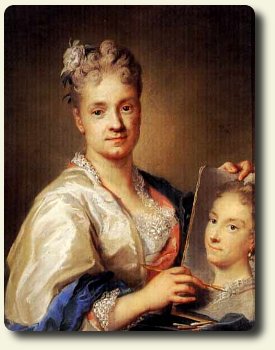
October 2010, Issue 9
Dollhouse Tourism
Page 24
Continue Dollhouse Tourism
By the 17th and 18th centuries, portrait miniatures began to flourish. A portrait miniature is a miniature portrait painting, usually executed in gouache, watercolor, or enamel. These small-scale portraits derived from the tradition of manuscript illumination, in which vellum pages with text was decorated in images using watercolor and bound together to form a book.

In the sixteenth century, these marginal images were adapted into a separate art form, usually a half-length or bust-length portrait painted in watercolor on vellum. Ranging in size from one inch to six inches in height, the portrait would then be housed in a metal locket sometimes decorated with pearls or diamonds, which could be worn or carried, or placed in a frame and displayed in the home.
As small in size as 40mm × 30mm (1½"-1¼"), portrait miniatures were often used as personal mementos or as jewelry or snuff box covers.
-self-portrait-probably-the-very-first-female-florentine-miniaturist.jpg)
Rosalba Carriera (1675-1757) was the most famous Italian portrait and miniature painter of her era. At age 24 she had achieved a reputation throughout Italy and abroad for her miniatures and crayon portraits. She was a Venetian Rococo painter who, in her younger years, specialized in portrait miniatures.
She began painting miniatures for the lids of snuff-boxes and was the first painter to use ivory for this purpose. Gradually, this work evolved into portrait-painting, for which she pioneered the exclusive use of pastels. Prominent foreign visitors to Venice, young sons of the nobility on the grand tour and diplomats all clamored to be painted by her.
The portrait miniature played an important role in the life of the middle and upper classes into the 19th century. But with the advent of photography, which made small-scale portraits available quickly, more cheaply, and on a much wider scale than before, the demand for these painted miniatures gradually ceased, although it continued to be practiced as a polite accomplishment by amateur artists.
Copyright© 2010
Custom Dolls, Houses & Miniatures / CDHM







